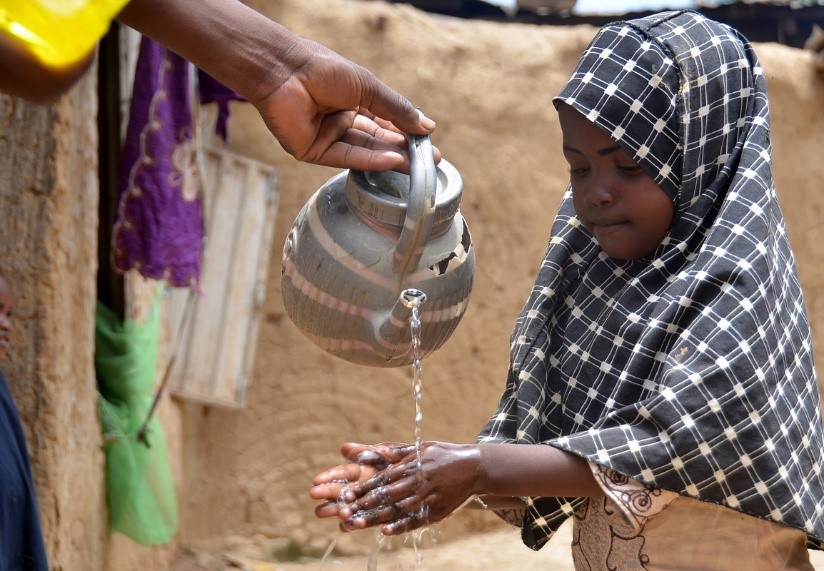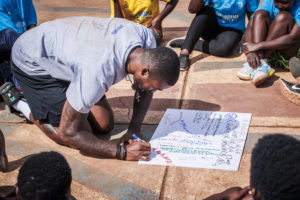
Challenges with mass NTD treatments in the time of COVID-19
10 février 2021
By Abdullahi Tsanni
Neglected Tropical Diseases, commonly known as NTDs, are a group of diverse parasitic and bacterial diseases that affect about 1.9 billion people worldwide. NTDs are largely present in Africa, Asia and Latin America, often in communities that lack access to water, sanitation and hygiene (WASH) facilities. These debilitating diseases such as trachoma, schistosomiasis (bilharzia) and onchocerciasis (river blindness) are preventable and treatable. However, they continue to cause severe disfigurement, blindness and other long-term disabilities in millions of people, posing a serious impediment to poverty reduction, socioeconomic development, and achieving Universal Health Coverage (UHC) according to the World Health Organization (WHO).
Mass Drug Administration in COVID-19
There are five strategies to prevent and control NTDs according to the World Health Organization (WHO). This includes preventive chemotherapy, individual case management, vector control, veterinary public health, and water, sanitation and hygiene. They implement some of these strategies through community-based approaches that rely on health workers and outreach in endemic communities.
As the coronavirus disease, COVID-19, spreads across African countries with fragile health systems, it prompted most countries to take drastic public health measures, including locking down of major cities to reduce the spread of the virus. But this preventive and containment measures such as lockdowns came with a costly price for other health issues including NTDs.
The COVID-19 pandemic resulted in disruption of NTDs prevention and control programmes worldwide. Medical services for people living with NTDs were ceased because of the travel restriction measures put in place by governments around the world. Besides the inability of NTDs pharmaceutical donors to maintain drug manufacturing for complexity of the supply chain of active ingredients, drug supply was also affected because of the closing of airports and increased costs of freight. In Africa’s most populous nation Nigeria, regular supply of drugs such as praziquantel used to treat schistosomiasis – one of several NTDs – was abruptly cut off, leaving affected communities unprotected against the disease.
Mass drug administration clearly plays an essential role in community-based interventions to address the burden of NTDs based on the WHO-developed strategy; it is central in the control and elimination of NTDs. However, as part of efforts to reduce the risk of COVID-19 transmission associated with large-scale community-based health interventions, WHO issued a general recommendation postponing mass treatment campaigns, active case-finding activities and population-based surveys for NTDs, in April 2020.
Subsequently, in May 2020, WHO reaffirmed its position on the postponement of mass treatment campaigns in another document entitled: “Community-based health care, including outreach and campaigns, in the context of the COVID-19 pandemic.” The document recommended that countries should monitor and re-evaluate the need to delay NTD programmes at regular intervals. Other recommendations were conducting risk-benefit assessment of planned community-based NTD activities on an event-by-event basis before restarting NTD campaigns, and consideration of the capacity of health systems to provide safe and high-quality healthcare amidst the COVID-19 pandemic.
In July 2020, WHO introduced a decision-making framework for implementing NTD programmes in COVID-19 pandemic. They planned the framework to provide guidance to health authorities and NTD programme managers based on two steps: a risk–benefit assessment, to decide if the planned NTD activity should proceed, and an examination of a list of precautionary measures, to decide how the planned activity should be executed. The risk–benefit assessment aims to guide governments and NTD programme managers in decision making on the resumption of planned NTD activities, and in taking precautionary measures to decrease the risk of transmission of COVID-19 associated with the planned NTD activities.
The WHO further recommended that NTD interventions should proceed if the associated benefits exceed the risks, and precautionary measures should be considered, with the aim of decreasing the risk of COVID-19 transmission associated with the intervention.
Restarting NTD programmes
A study published by Sightsavers, a UK-based non-profit dedicated to ending NTDs around the globe, had warned that not restarting mass drug administration could enhance the risk of NTD transmission, and fail to leverage behaviour change messaging on the importance of hand and face washing and improved sanitation – a common strategy for several NTDs that also reduces the risk of COVID-19 spread. They call this the “hybrid approach.” According to the report, if adopted, the ‘hybrid approach’ would see NTD practices such as behavioural change messaging and water, sanitation and hygiene interventions also help prevent the spread of COVID-19.
The fallout of the COVID-19 pandemic has had a significant effect on several gains made in the control and elimination of NTDs, including on the roadmap toward ending various NTDs around the world. Thus, the resumption of mass drug administration is essential to reaching the targets of the new Roadmap 2021-2030 for the elimination of NTDs, and it requires the use of new tools and approaches for restarting NTD programmes amidst COVID-19. Thanks to Sightsavers, and partners, a new set of COVID-19 Risk Assessment and Mitigation Action (RAMA) tools, is helping countries, including Nigeria, restart mass drug administration programmes.
The RAMA tools – one for treatment distribution, a second for disease specific surveys, and a third for case finding and surgical outreach – are based on WHO’s risk assessment tool on mass gathering; they complement WHO’s COVID-19 interim guidance document on considerations for implementing mass treatment campaigns for NTDs. Citing the benefits of RAMA, Philip Downs, technical director for NTDs at Sightsavers, notes that RAMA tools help NTD program managers to document and verify the command and control structure that will monitor the COVID-19 trends in areas where treatments are taking place, and use the risk communication strategy that will involve community leaders in the planning of NTD activities as well as enable independent technical advisors to evaluate the written standard operating procedures (SOPs) for how activities will be modified.
In September 2020, after conducting a rigorous assessment process in line with WHO’s guidance, Sightsavers resumed mass NTD treatments in some states in Nigeria. Additionally, to ensure treatment distribution is COVID-safe, trained local volunteers and drug distributors go from house to house, rather than distributing medicine in a central location, while observing strict guidelines on social distancing, hygiene, protective equipment and other safety measures outlined by the Nigerian government and WHO.
The interim suspension of NTD programmes and morbidity management services because of the COVID-19 pandemic has threaten NTD gains made so far. However, the restarting of mass NTD treatments through the use of innovative tools such as RAMA, is a great step in ensuring that the fight against NTDs continues in the time of COVID-19 pandemic. There is a need to strengthen health systems and disease surveillance as well as leverage new tools for restarting of NTD programmes, including change behavior messaging and handwashing, in the global fight against COVID-19.
Abdullahi Tsanni is a science journalist based in Abuja, Nigeria. This reporting is part of the #LinesofImpact Project on Neglected Tropical Diseases (NTDs) in commemoration of World NTD Day, supported by Speak Up Africa.

